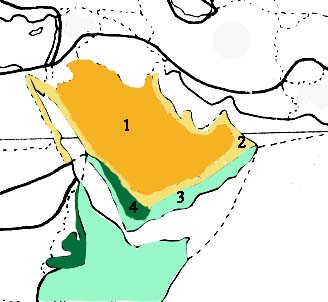Phytogeography
The vegetation of Arabian Peninsula consists of a number of vegetation units, ranging from dwarf shrublands, open xeromorphic grasslands, succulent and sclerophyllous shrublands, open thorn woodlands, evergreen and deciduous woodlands, etc. For several decades Arabian Peninsula was following the divisions suggested by Michel Zohary (Geobotanical Foundations of the Middle East, 1973). According to this earlier concept, Arabian Peninsula was divided into two floral regions, the Saharo-Arabian region and the Sudanian region. The former covering the arid and extra arid regions while the latter, further divided into Nubo-Sindian (covering the coastal regions of Arabian Peninsula) and the Eritreo-Arabian Provinces (covering the mountains of southwestern region of Arabian Peninsula). Since the vegetation of Arabian Peninsula is more or less similar to that of the north eastern and northern parts of the African Continent, present day phytogeographers are of the opinion that the phytogeographical divisions within the northeastern and eastern parts of Africa should be extended towards east to cover the regions within the Arabian Peninsula too, namely (1.) Saharo-Sindian regional zone which is further divided into Arabian regional subzone (=Saharo-Arabian region of Zohary in 1973 or the Saharo-Sindian region of Eig in 1938) and Nubo-Sindian local centre of endemism (=Nubo-Sindian province of the Sudanian region of Zohary in 1973 or the Sudano-Deccanian region of Eig in 1938), covering the coastal region of northwestern region eastern slopes of southern Hijaz Mountains, southern regions and the Arabian Gulf coast (2.) the Somali-Masai regional centre of endemism, covering the coastal and the low altitude areas of the western slopes of Hijaz Mountains and the ( 3.) Afromontane archipelago-like regional centre of endemism, covering the high altitude regions of southern Hijaz Mountains.
Dominant plants reported from each of these chorological units are:

1. Arabian Regional sub zone. 2. Nubo-Sindian local centre of endemism. 3. Somali-Masai regional centre of endemism. 4.Afromontane Archipelago-like regional centre of endemism.
Arabian Regional subzone
The Arabian Regional subzone is the largest phytogeographical reigon in Saudi Arabia, covering central, northern and eastern regions. This area is generally arid with an average annual rainfall of 120 mm and an average maximum temperature of 480 C. during July-September and an average minimum temperature of 80 C. during December-February. Dominant species include:
Agathophora alopecuroides, Anabsis articulata, Astragalus spinosus, Calligonum comosum, Gymnocarpos decandrum, Haloxylon salicornicum, Helianthemum lippii, Moltkiopsis ciliata, Morettia canescens, Neurada procumbens, Paronychia Arabica, Polycarpaea repens, Retama raetam, Rhanterium epapposum, Rhazya stricta, Salsola tetrandra, Sclerocephalus arabicus, Traganum nudatum, Zilla spinosa.
Nubo-Sindian local centre of endemism
This is a narrow strip of land bordering the coastal regions of the Arabian Peninsula, often difficult to differentiate from the neighbouring phytogeographical diivisions. Phytogeographers are of the view that the area covered by the Nubo-Sindian zone, particularly in the southern regions of the Arabian Peninsula should be extended further towards the interior parts of the Peninsula. Dominant species representing this phytochorion are:
Aerva javanica, Acacia raddiana, Acacia tortilis; Calotropis procera, Capparis sinaica, Cocculus pendulus, Forsskaolea tenacissima, Halopeplis perfoliata, Indigofera spinosa Lasiurus scindicus. Leptadenia pyrotechnica, Panicum turgidum, Pennisetum divisum, Periploca aphylla, Salvadora persica, Salvia aegyptiaca
Somalia-Masai regional centre of endemism
This region covers the low altitude areas of southwestern region. These areas are influenced by the subtropical climate and dominated by vegetation similar to that of north east Africa.
Acacia hamulosa, Acacia mellifera, Barbeya oleoides, Breonadia salicina, Cadaba longifolia, Carissa edulis, Celtis Africana, Commiphora spp., Dodonaea angustifolia, Euclea schimperi, Ficus cordata ssp. salicifolia, Ficus palmata, Forsskaolea viridis, Maytenus parviflorus, Ochna inermis, Osyris quadricinta, Premna resinosa, Psiadia puntulata, Pterolobium stellatum, Sarcostemma viminale. Trichilia emetica.
Afromontane Archipelago-like Regional centre of endemism
The areas belonging to the this phytochorion is the most important part of Saudi Arabia and the Arabian Peninsula in general in terms of vegetation and speciation. These areas are situated between 1000 to 3000 m above sea level and are similar to the high altitude mountains of north-eastern and eastern parts of Africa, both floristically and ecologically.
Acacia origena, Buddleja polystachya, Cadia purpurea, Campanula edulis, Clutia richardiana, Dombeya torrida, Erica arborea, Felicia dentata, Hypericum revolutum, Juniperus procera, Lavandula dentata, Maesa lanceolata, Myrsine Africana, Rhamnus staddo, Rumex nervosus, Salvia merjamie, Senecio hadiensis, Solanum schimperianum, Teclea nobilis
Among the major intruders, Mediterranean and Irano-Turanian elements play a major role in the flora of Saudi Arabia, although they do not form any communities. The plants belonging to the former group is found in the northwestern and western provinces, including the northwestern Hijaz Mountains. Prominent species of this chorotype are: Juniperus phoenicea, Olea europaea, Rhus tripartita, Hypericum hircinum, Lonicera etrusca, Myrtus communis, Umblicus horizontalis etc. Among the dominant species of the Irano-Turanian phytogeographic region, majority of them are found in the northern and northeastern provinces of Saudi Arabia. Examples of this category are: Achillea fragrantissima, Astracantha echinatus ssp. arabicus, Binertia cycloptera, Noaea mucronata, Prunus korshinskyi, etc